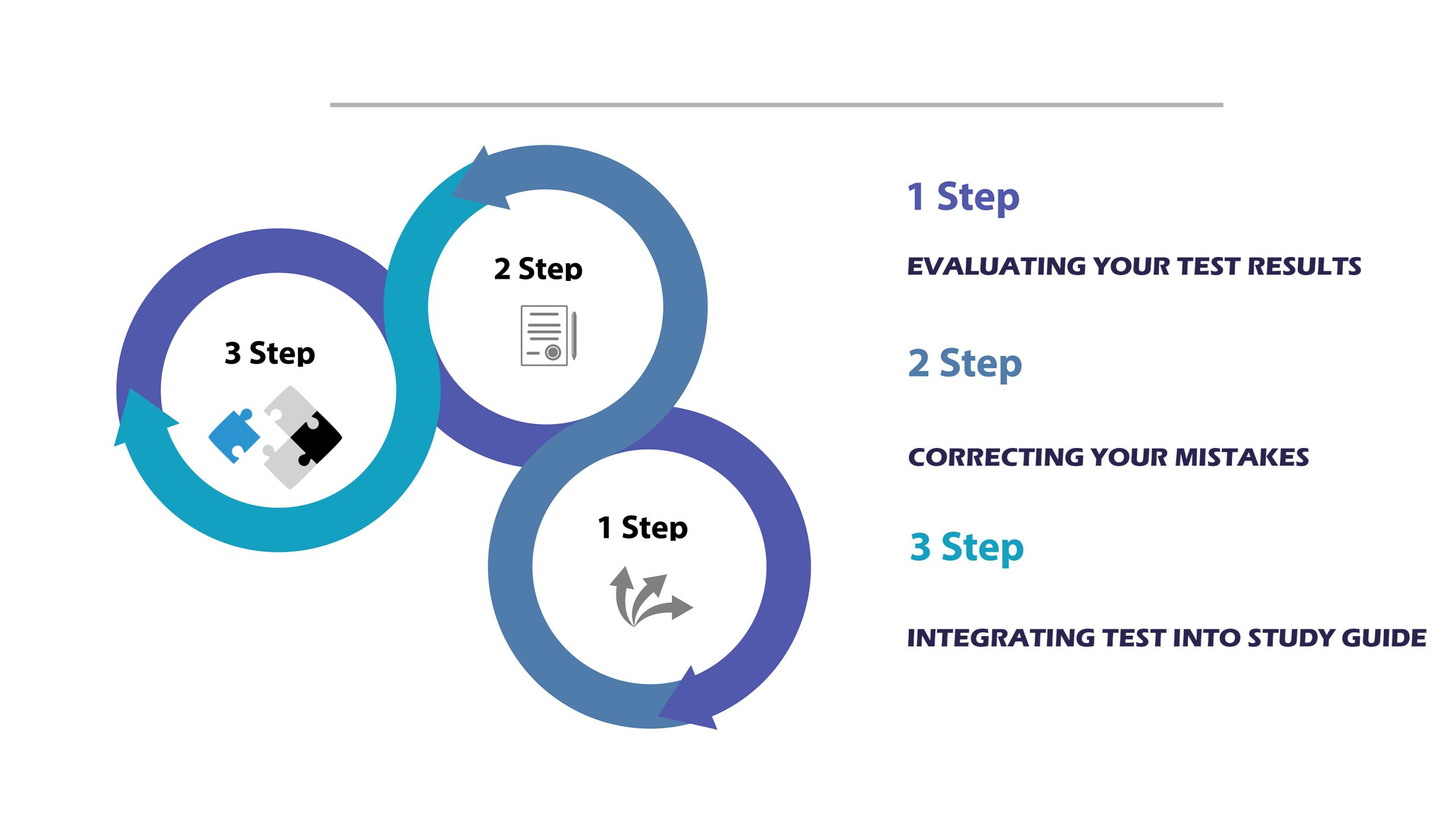And #11 Successful Students Learn Independently
19 Studying
Learning From Past Tests

While it may seem strange to talk about how to learn from past tests before other topics about tests, it is important that students use test results to their greatest benefit. Some of your most important learning begins when your graded test paper is returned to you. Your first reaction, of course, is to see what grade you received and how you did compared with your classmates. This is a natural reaction. However, when students don’t achieve the results on tests and exams that they would like, it is tempting to just try to do better next time and forget about it.
Reviewing your test and examining the questions you got wrong can help you determine what you need to change – the problem could lie in the way you take tests, study for tests or even how well you read and understand test questions. Based on your analysis of your test, identify the kind of corrective steps you should take to improve your learning and test performance. Implement those steps as you begin your preparation for your next test. If you don’t learn from your mistakes, you are doomed to repeat them; if you don’t learn from your successes, it will be harder to repeat them.
How to use past tests to improve your future results
Three step process

Step 1: Evaluating your test results
- When you receive your test back, sit quietly and take a close look at it.
- What questions did you get wrong? What kind of mistakes were they? Do you see a pattern?
- What questions did you get right? What were your strengths? What can you learn from the professor’s comments?
- Now think of the way in which you prepared for the exam. Were you prepared for the exam? Did you study the right material? What surprised you?
- Did you read the entire test before starting? Did your time allocation work well, or were you short of time on certain parts of the exam?
Step 2: Correcting Your Mistakes
The second step in making your test work for you is to correct your wrong answers. The last time you wrote the information (when you took the test), you created a link to wrong information in your memory, so that must be corrected.
- For multiple-choice questions, write out the question stem with the correct answer to form a single correct sentence or phrase.
- For true-or-false questions, write the full statement if it is true; if it is false, reword it in such a way that it is true (such as by inserting the word “not”). Then write the new statement.
- For math and science questions involving calculations, redo the entire solution with the calculations written out fully.
- You need not rewrite an entire essay question if you did not do well, but you should create a new outline for what would be a correct answer. Make sure you incorporate any ideas triggered by your professor’s comments.
- When you have rewritten all your answers, read them all out loud before incorporating your new answers in your notes.
Step 3: Integrating Your Test into Your Study Guide
Your corrected quizzes and midterm exams are an important study tool for final exams. Make sure you file them with your notes for the study unit. Take the time to annotate your notes based on the quizzes, test or exam. Pay particular attention to any gaps in your notes on topics that appeared in the quiz or exam. Research those points in your text or online and complete your notes. Review your tests throughout the term (not just before the final) to be sure you cement the course material into your memory. When you prepare for the final exam, start by reviewing your quizzes and other tests to predict the kinds of questions the professor may ask on the final. This will help focus your final studying when you have a large amount of coursework to cover.
Exam Errors and How to Correct Them
Preparation / Content Errors
- Incorporate weekly review sessions.
- Practice predicting possible questions.
- Go to all classes, labs, and review sessions.
Focus Errors or Carelessness
- Read the entire test before starting.
- Slow down during the test.
- Read carefully and think before answering.
- Check your work.
If You Don’t Get Your Test Back
If your professor chooses not to return tests to students, make an appointment to see the professor soon after the test to review it and your performance. Take notes on what you had trouble with and the expected answers. Add these notes into your study guide. Make sure you don’t lose out on the opportunity to learn from your results.
Effective Studying

Effective studying is an ongoing process of reviewing course material. The first and most important thing you should know is that studying is not something you do a few days before an exam. To be effective, studying is something you do as part of an ongoing learning process, throughout the duration of the term.
Studying Every Day
Studying begins after each class or assignment when you review your notes. Each study session should involve three steps:
- Gather your learning materials. Take time to merge your class notes with your reading notes. How do they complement each other? Stop and think. What do the notes tell you about your material? What aspects of the material are you unsure about? Do you need to reread a part of your text? Write down any questions you have for your professor and pay a visit during office hours. It is better to clear up any misconceptions and get your questions answered soon after you are exposed to the material, rather than to wait, for two reasons: (1) the question or doubt is fresh in your mind and you won’t forget about it and (2) professors usually build their lessons on material already presented. If you don’t take these steps now, you are setting yourself up for problems later in the course.
- Apply or visualize. What does this material mean to you? How will you use this new knowledge? Try to find a way to apply it in your own life or thoughts. If you can’t use the knowledge right away, visualize yourself using the knowledge to solve a problem or visualize yourself teaching the material to other students.
- Cement your knowledge. If you use the two-column notetaking method, cover up the right side of your notes with a piece of paper, leaving the questions in the left column exposed. Test yourself by trying to answer your questions without referring to your notes. How did you do? If you are unsure about anything, look up the answer and write it down right away. Don’t let a wrong answer be the last thing you wrote on a subject, because you will most likely continue to remember the wrong answer.
Studying in Course Units
At the end of each unit, or at least every two weeks or so, use your notes and textbook to write an outline or summary of the material in your own words. (Remember the paragraphs you wrote to summarize each class or reading? They’ll be very helpful to you here.) After you have written the summary or outline, go back and reread your outline from the prior unit followed by the one you just wrote. Does the new one build on the earlier one? Do you feel confident you understand the material?
Studying before the Exam
At least a week before a major exam, ask yourself these questions:
- What has the professor said about what is included on the exam?
- Has the professor said anything about what types of questions will be included?
- If you were the professor, what questions would you ask on an exam?
Challenge yourself to come up with some really tough open-ended questions. Think about how you might answer them. Be sure to go to any review sessions the professor holds.
Now go back and review your outlines. Do they cover what the professor has suggested might be on the exam? After reviewing your outlines, reread the sections of your notes that are most closely associated with expected exam questions. Pay special attention to those items the professor emphasized during class.
More Tips for Success

- Schedule a consistent study-review time for each course at least once a week, in addition to your class and assignment time. Keep to that schedule as rigorously as you do your class schedule. Use your study time to go through the steps outlined earlier; this is not meant to be a substitute for your assignment time.
- Get yourself in the right space. Choose to study in a quiet, well-lit space. Your chair should be comfortable but provide good support. Remember that libraries were designed for reading and should be your first option.
- Minimize distractions. Turn off your cell phone and get away from social media, television, other nearby activities, and chatty friends or roommates. All of these can cut into the effectiveness of your study efforts. Multitasking and studying don’t mix.
- If you will be studying for a long time, take short breaks at least once an hour. Get up, stretch, breathe deeply, and then get back to work. (If you keep up with your daily assignments and schedule weekly review sessions for yourself—and keep them—there should be almost no need for long study sessions.)
Effective Study Self Check
How to study from the Learning Scientists!
From learningscientist.org, we have more advice on how to study. Based on research by cognative scientist, these six study strategies out perform typical student study strategies such as re-reading or highlighting:
Group Studying
Study groups are a great idea—as long as they are thoughtfully managed. A study group can give you new perspectives on course material and help you fill in gaps in your notes. Discussing course content will sharpen your critical thinking related to the subject, and being part of a group to which you are accountable will help you study consistently. In a study group, you will end up “teaching” each other the material, which is the strongest way to retain new material. But remember, being in a group working together doesn’t mean there will be less work for you as an individual; your work will just be much more effective.
Picking Group Members
- Think small. Limit your study group to no more than three or four people. A larger group would limit each student’s participation and make scheduling of regular study sessions a real problem.
- Go for quality. Look for students who are doing well in the course, who ask questions, and who participate in class discussions. Don’t make friendship the primary consideration for who should be in your group. Meet up with your friends instead during “social time”—study time is all about learning.
- Look for complementary skills and learning strengths. Complementary skills make for a good study group because your weaknesses will be countered by another student’s strengths. When a subject requires a combination of various skills, strengths in each of those skills is helpful (e.g., a group with one student who is really good at physics and another at math would be perfect for an engineering technology course). Finally, a variety of learning strengths is helpful because each of you pick up differing signals and emphases from the professor that you can share with each other, so you will not likely miss important points.
Meet regularly. When you first set up a study group, agree to a regular meeting schedule and stick to it. Moving study session times around can result in nonparticipation, lack of preparation, and eventually the collapse of the study group.

How to conduct a group study session
- Assign a moderator, and rotate the role of moderator or discussion leader. This helps ensure “ownership” of the group is spread equally across all members and ensures active participation and careful preparation.
- Define an agenda and objectives. Give your study sessions focus so that you don’t get sidetracked. Based on requests and comments from the group, the moderator should develop the agenda and start each session by summarizing what the group expects to cover and then keep the group to task.
- Assign follow-up work. If there is any work that needs to be done between meetings, make sure that all team members know specifically what is expected of them and agree to do the work.
- Include some of the following items on your agenda:
- Review and discuss class and assignment notes since your last meeting.
- Discuss assigned readings.
- Quiz each other on class material.
- “Reteach” aspects of the material team participants are unsure of.
- Brainstorm possible test questions and responses.
- Review quiz and test results and correct misunderstandings.
- Critique each other’s ideas for paper themes and approaches.
- Define questions to ask the professor.
Key Takeaways
- Review your past tests to learn from your mistakes. Evaluate your results and consider why you got answers right or wrong; think about how your studied for this test and what you might need to change about your study habits; and finally, judge whether you managed your test-taking tasks well. Next, correct your mistakes and write out the correct answers. Finally, make your past tests part of your study notes and make adjustments to how you study or take tests to prevent making similar mistakes in the future.
- Frequent study is more effective than just studying before a test or exam. Study every day merging your class and reading notes, and creating questions for your professor on areas of confusion.
- Apply or visualize the material to make it more meaningful and cement your knowledge by testing yourself.
- Study in course units by using notes and text to create summaries or outlines of the material.
- A least a week before a major test or exam, gather what you know about what the test will cover, review your summaries and outlines and come up with likely test questions to use to test yourself. You may need to go back to review sections of notes based on expected test questions.
- Group study that is well managed can be an effective way to deepen your learning and understanding. Pick quality group members, meet regularly, assign a rotating moderator, set up an agenda and assign follow up work for group members.
 Want More? The Learning Portal has resources to help you decide what to study.
Want More? The Learning Portal has resources to help you decide what to study.

